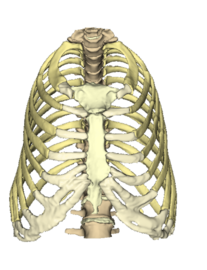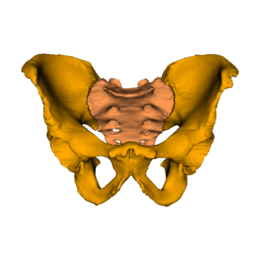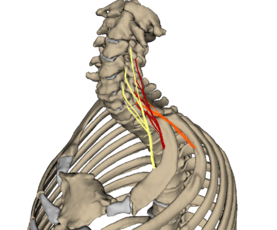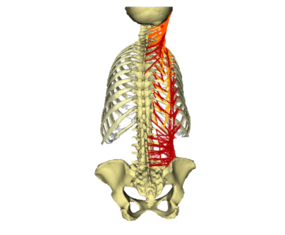Rumpfwand/en: Unterschied zwischen den Versionen
Becher (Diskussion | Beiträge) (Die Seite wurde neu angelegt: „==Function and tasks==“) |
Becher (Diskussion | Beiträge) (Die Seite wurde neu angelegt: „Back to the anatomy overview“) |
||
| (4 dazwischenliegende Versionen desselben Benutzers werden nicht angezeigt) | |||
| Zeile 65: | Zeile 65: | ||
==Function and tasks== | ==Function and tasks== | ||
| − | + | The trunk skeleton and the musculature ensure the stability of the upper body. It is only thanks to the bones and muscles in the trunk that people can walk and stand upright. In addition, almost all important organs of the body, with the exception of the brain, are located in the trunk. | |
| − | + | Most digestive organs such as stomach, small intestine, large intestine, spleen, pancreas and liver are located in the abdomen. | |
| − | + | The liver is the body's most important metabolic organ. It is particularly important for nutrient processing and detoxification of the body. | |
| − | + | The kidneys, which also belong to the abdominal organs, filter the blood and support the excretion of metabolic waste products. Another function is the regulation of blood pressure and water balance. | |
| − | + | The chest contains both heart and lungs. The heart is the central organ for blood circulation. | |
| − | + | The lungs enrich the blood with oxygen. Carbon dioxide is extracted from the blood and breathed out. | |
| − | + | The bladder, the urinary tract and the sexual organs are located in the area of the pelvis. The urine produced in the kidneys is excreted via the bladder and the urinary tract. The reproductive organs are primarily used for reproduction. | |
| − | == | + | ==Anatomy and Structure== |
| − | + | The lower part of the trunk is the pelvis. It consists of the two hip bones (Ossa coxae) containing the internal pelvic organs. | |
| − | + | The abdomen is located between the thorax (sternum tip height) and the pelvis (up to the groin ligament). Inside the abdomen is a fluid-filled cavity - the abdominal cavity. The diaphragm forms the upper limit of the abdominal cavity. Below it it is bounded by the hip bone and the pelvic floor. | |
| − | + | The back reaches from the loin or coccyx to the lower part of the neck. This includes the spine, the posterior parts of the ribs and soft tissues such as connective tissue and back muscles. | |
| − | + | The thorax is formed by the thoracic spine, the sternum and the ribs. The respiratory muscles are attached to the outside and inside of the thorax. | |
---- | ---- | ||
| − | '''[[Special:MyLanguage/Übungsaufgaben| | + | '''[[Special:MyLanguage/Übungsaufgaben|Exercises]]''' |
| − | [[Special:MyLanguage/Anatomie| | + | [[Special:MyLanguage/Anatomie|Back to the anatomy overview]] |
Aktuelle Version vom 2. Januar 2020, 10:31 Uhr
Inhaltsverzeichnis
Subdivision of the trunk
trunk skeleton
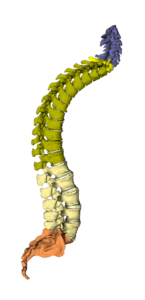
Spine
Bony spine
Structure of a vertebra
Cervical spine
Thoracic spine
Lumbar spine
Sacrum and coccyx
Muscles of the anterior and posterior trunk
Abdominal and thoracic muscles
Chest muscles
Front and posterior abdominal wall muscles
Lateral, oblique abdominal wall muscles
Autochthonous back muscles
Back muscles - medial tract
Back muscles - lateral tract
Short neck and head joint muscles
Inguinal canal (Coming soon)
Definition
The trunk, anatomically also known as the truncus, includes the spine, thorax, abdomen, dorsum and pelvis. The thorax is formed by the thoracic spine, ribs and sternum. The pelvic and shoulder girdle, also part of the trunk skeleton, enable the human being to walk upright.
Almost all organs, except the brain and the skin, are located in the trunk or distributed in the individual sections. The abdomen contains the stomach, small and large intestine, spleen, liver, kidneys and pancreas. The chest contains the heart and lungs. The bladder and sexual organs are located in the pelvis.
Function and tasks
The trunk skeleton and the musculature ensure the stability of the upper body. It is only thanks to the bones and muscles in the trunk that people can walk and stand upright. In addition, almost all important organs of the body, with the exception of the brain, are located in the trunk. Most digestive organs such as stomach, small intestine, large intestine, spleen, pancreas and liver are located in the abdomen. The liver is the body's most important metabolic organ. It is particularly important for nutrient processing and detoxification of the body. The kidneys, which also belong to the abdominal organs, filter the blood and support the excretion of metabolic waste products. Another function is the regulation of blood pressure and water balance. The chest contains both heart and lungs. The heart is the central organ for blood circulation. The lungs enrich the blood with oxygen. Carbon dioxide is extracted from the blood and breathed out. The bladder, the urinary tract and the sexual organs are located in the area of the pelvis. The urine produced in the kidneys is excreted via the bladder and the urinary tract. The reproductive organs are primarily used for reproduction.
Anatomy and Structure
The lower part of the trunk is the pelvis. It consists of the two hip bones (Ossa coxae) containing the internal pelvic organs. The abdomen is located between the thorax (sternum tip height) and the pelvis (up to the groin ligament). Inside the abdomen is a fluid-filled cavity - the abdominal cavity. The diaphragm forms the upper limit of the abdominal cavity. Below it it is bounded by the hip bone and the pelvic floor. The back reaches from the loin or coccyx to the lower part of the neck. This includes the spine, the posterior parts of the ribs and soft tissues such as connective tissue and back muscles. The thorax is formed by the thoracic spine, the sternum and the ribs. The respiratory muscles are attached to the outside and inside of the thorax.
